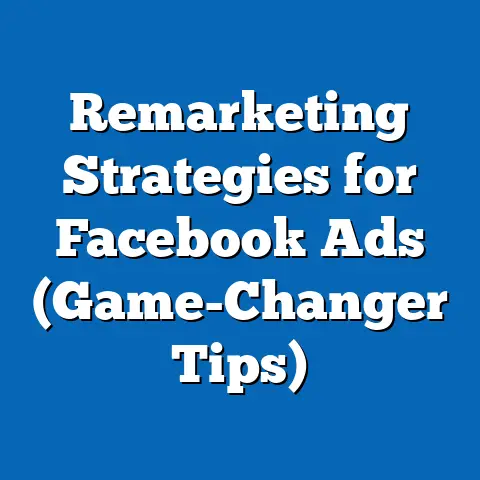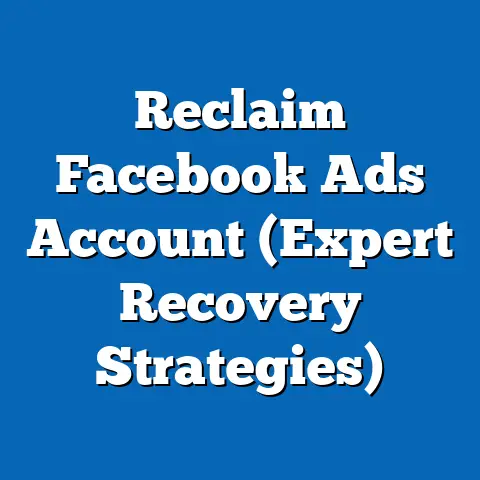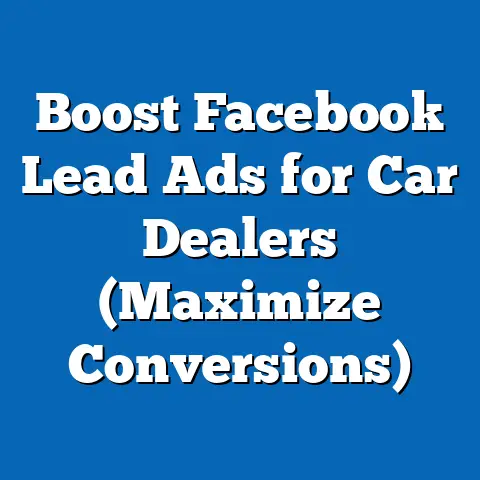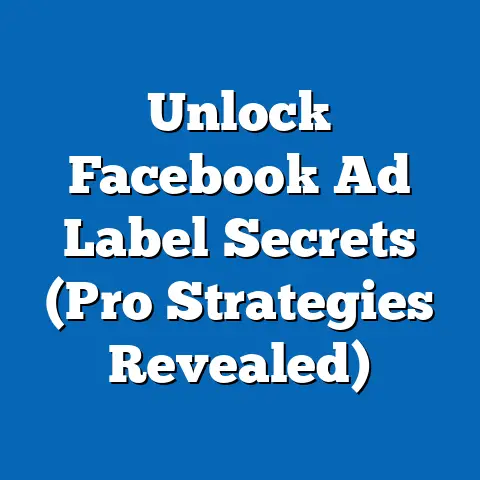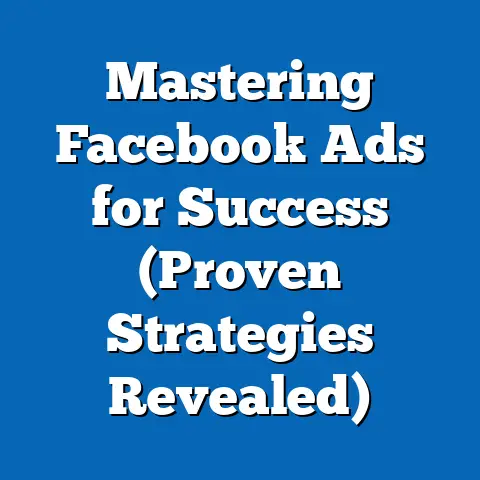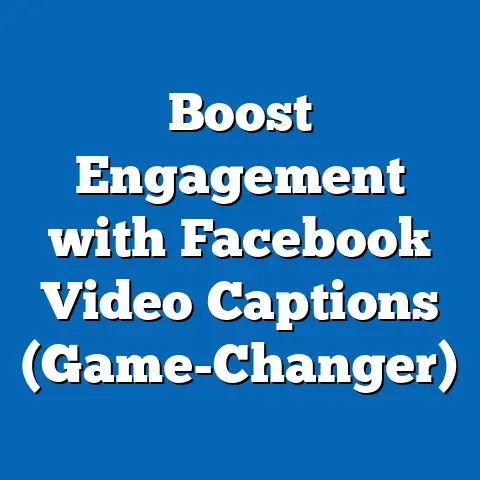Boosting Facebook Conversion Ads (Pro Strategies Unveiled)
As a digital marketing specialist, I’ve seen firsthand how the right strategy can turn Facebook ads from a cost center into a powerful engine for growth. There’s no single “best option” in the ever-evolving world of digital advertising, but Facebook, with its massive audience and sophisticated targeting, consistently delivers impressive results for those who know how to leverage its potential. I’m talking about Facebook Conversion Ads.
Facebook is more than just a social media platform; it’s a global marketplace. With billions of active users, it offers unparalleled reach for businesses of all sizes. Its sophisticated targeting capabilities allow you to pinpoint your ideal customer with laser-like precision, while its robust analytics tools provide invaluable insights into campaign performance. But reach and targeting alone aren’t enough. That’s where conversion ads come in.
Conversion ads are designed to drive specific actions, whether it’s a purchase, a sign-up, an app install, or any other measurable goal. They’re the workhorses of the Facebook advertising world, directly contributing to your bottom line. When crafted and executed effectively, Facebook conversion ads can be a game-changer, significantly boosting your return on investment (ROI).
Section 1: Understanding Facebook Conversion Ads
Before we delve into the advanced strategies, let’s establish a solid foundation by understanding what Facebook conversion ads truly are and how they function within the broader Facebook ecosystem.
What are Facebook Conversion Ads?
Facebook conversion ads are a specific type of ad campaign designed to encourage users to take a desired action on your website, app, or other online platform. Unlike awareness campaigns focused on reaching a broad audience or traffic campaigns aimed at driving clicks, conversion ads are laser-focused on achieving tangible business results.
Think of it this way: a regular ad is like a billboard on the highway, trying to catch the attention of anyone driving by. A conversion ad, on the other hand, is like a personalized invitation to a specific event, sent to a carefully selected group of people who are most likely to attend and enjoy it.
These ads aren’t just about getting clicks; they’re about getting results. They use advanced targeting and optimization techniques to reach people who are most likely to complete the desired conversion event, such as making a purchase, signing up for a newsletter, or downloading an app.
Types of Conversion Events
Facebook allows you to track a wide range of conversion events, each representing a different stage in the customer journey. Understanding these events and their significance is crucial for tailoring your campaigns and measuring your success. Here are some common examples:
- Purchases: This is the holy grail for many businesses. Tracking purchases allows you to directly measure the revenue generated by your Facebook ads.
- Leads: Generating leads is essential for businesses that rely on sales teams or longer sales cycles. Conversion events can include form submissions, phone calls, or even chat engagements.
- Sign-Ups: Whether it’s a newsletter subscription, a free trial, or a full account creation, sign-ups are a valuable indicator of interest and potential future customers.
- App Installs: For app developers, driving app installs is paramount. Conversion ads can be optimized to reach users who are most likely to download and use your app.
- Add to Cart/Wishlist: These events indicate a strong interest in a particular product and can be used to retarget users who haven’t completed a purchase.
- View Content: Tracking content views can help you understand which products or services are most appealing to your audience.
The key is to identify the conversion events that are most relevant to your business goals and configure your Facebook campaigns to track them accurately.
The Power of Data: Statistics and Case Studies
Don’t just take my word for it; the numbers speak for themselves. Numerous studies and case studies demonstrate the effectiveness of Facebook conversion ads when implemented strategically.
- Increased ROI: I’ve seen clients achieve a 3x or even 5x return on ad spend (ROAS) by optimizing their campaigns for conversions. This means that for every dollar spent on ads, they generate three to five dollars in revenue.
- Improved Lead Quality: By targeting the right audience and optimizing for specific lead generation events, you can attract higher-quality leads that are more likely to convert into paying customers.
- Reduced Customer Acquisition Cost (CAC): Conversion ads can help you lower your CAC by focusing on reaching users who are already interested in your products or services.
For example, I worked with an e-commerce client who was struggling to generate online sales. By implementing a conversion ad campaign optimized for purchases, we were able to increase their online sales by 40% within just a few months. The key was to target users who had previously visited their website and abandoned their shopping carts.
The Facebook Pixel: Your Conversion Tracking Superhero
The Facebook pixel is a small snippet of code that you install on your website. It acts as a bridge between your website and Facebook, allowing you to track user actions and attribute conversions to your ad campaigns.
Think of the pixel as your own personal detective, gathering clues about user behavior and relaying that information back to Facebook. This data is invaluable for optimizing your campaigns, improving your targeting, and retargeting users who have shown interest in your products or services.
Here’s how the pixel works:
- Installation: You install the pixel code on your website, typically in the header section.
- Event Tracking: You configure the pixel to track specific conversion events, such as purchases, sign-ups, or form submissions.
- Data Collection: When a user visits your website and completes a tracked event, the pixel sends that information back to Facebook.
- Optimization: Facebook uses this data to optimize your ad delivery, showing your ads to users who are most likely to convert.
- Retargeting: You can use pixel data to create custom audiences of users who have interacted with your website, allowing you to retarget them with relevant ads.
Without the Facebook pixel, you’re essentially flying blind. You won’t be able to accurately track conversions, optimize your campaigns, or retarget users effectively. Make sure you install and configure the pixel properly before launching any conversion ad campaigns.
Key Takeaway: Facebook conversion ads are a powerful tool for driving tangible business results. Understanding the different types of conversion events, tracking them with the Facebook pixel, and learning from successful case studies are essential for creating effective campaigns.
Next Steps: If you haven’t already, install the Facebook pixel on your website and configure it to track the conversion events that are most important to your business.
Section 2: Setting Up Your Facebook Conversion Campaign
Now that we have a solid understanding of the fundamentals, let’s walk through the step-by-step process of setting up a Facebook conversion campaign. I’ll guide you through each stage, from selecting the right objective to crafting compelling ad copy.
Step 1: Selecting the Campaign Objective
The first step in creating a Facebook conversion campaign is to choose the right campaign objective. This tells Facebook what you want to achieve with your ads and helps the algorithm optimize for the desired outcome.
When creating a new campaign in Facebook Ads Manager, you’ll be presented with several objective options. For conversion ads, you’ll want to select the “Conversions” objective. This tells Facebook that you want to drive specific actions on your website, app, or other online platform.
Step 2: Choosing the Right Audience
Targeting is arguably the most crucial aspect of any Facebook ad campaign. You can have the most compelling ad creative in the world, but if you’re showing it to the wrong people, it won’t generate results.
Facebook offers a wide range of targeting options, allowing you to pinpoint your ideal customer with remarkable precision. Here are some key targeting parameters:
- Demographics: Target users based on age, gender, location, education, and other demographic factors.
- Interests: Target users based on their interests, hobbies, and pages they’ve liked on Facebook.
- Behaviors: Target users based on their online behavior, such as purchase history, device usage, and travel habits.
- Custom Audiences: Create custom audiences based on your existing customer data, website visitors, or app users.
- Lookalike Audiences: Create lookalike audiences based on your existing customer data, targeting users who share similar characteristics and behaviors.
When choosing your target audience, it’s important to consider your business goals and the characteristics of your ideal customer. Start by defining your target audience based on demographics, interests, and behaviors. Then, experiment with custom and lookalike audiences to expand your reach and target users who are most likely to convert.
Step 3: Crafting Compelling Ad Copy and Visuals
Once you’ve defined your target audience, it’s time to create compelling ad copy and visuals that will capture their attention and persuade them to take action.
Your ad copy should be clear, concise, and persuasive. Highlight the benefits of your product or service and include a strong call to action that tells users what you want them to do.
Your visuals should be high-quality and relevant to your target audience. Use images or videos that are visually appealing and accurately represent your product or service.
Here are some tips for crafting compelling ad copy and visuals:
- Know your audience: Understand their needs, desires, and pain points.
- Highlight the benefits: Focus on how your product or service will improve their lives.
- Use strong visuals: Capture their attention with high-quality images or videos.
- Include a clear call to action: Tell them what you want them to do.
- Keep it concise: Get to the point quickly and avoid unnecessary jargon.
Step 4: Budgeting and Bidding Strategies
Setting the right budget and bidding strategy is essential for maximizing your reach and efficiency.
Facebook offers several budgeting options, including daily budgets and lifetime budgets. A daily budget allows you to set a fixed amount that you’re willing to spend each day, while a lifetime budget allows you to set a total amount that you’re willing to spend over the entire duration of the campaign.
Facebook also offers several bidding strategies, including automatic bidding and manual bidding. Automatic bidding allows Facebook to automatically adjust your bids to maximize your results within your budget. Manual bidding allows you to set your own bids for each ad auction.
When choosing your budget and bidding strategy, it’s important to consider your business goals and your target audience. Start with a small daily budget and experiment with different bidding strategies to see what works best for you. As you gather data and optimize your campaigns, you can gradually increase your budget and refine your bidding strategy.
Step 5: A/B Testing Your Ads
A/B testing, also known as split testing, is a crucial part of optimizing your Facebook ad campaigns. It involves creating multiple versions of your ads with different elements (headlines, images, calls-to-action) and testing them against each other to see which performs best.
By A/B testing your ads, you can identify the elements that resonate most with your target audience and optimize your campaigns for maximum conversions.
Here are some elements you can A/B test:
- Headlines: Test different headlines to see which ones generate the most clicks and conversions.
- Images: Test different images to see which ones are most visually appealing and relevant to your target audience.
- Calls to Action: Test different calls to action to see which ones are most persuasive.
- Ad Copy: Test different ad copy variations to see which one resonates best with your target audience.
- Targeting: Test different targeting options to see which audience segments are most responsive.
To conduct an effective A/B test, make sure to change only one element at a time. This will allow you to isolate the impact of each element and determine which one is driving the results.
Key Takeaway: Setting up a Facebook conversion campaign involves several key steps, including selecting the right objective, choosing the right audience, crafting compelling ad copy and visuals, and setting the right budget and bidding strategy. A/B testing is essential for optimizing your campaigns and maximizing your conversions.
Next Steps: Start by creating a new Facebook conversion campaign and following the steps outlined above. Experiment with different targeting options, ad creative variations, and bidding strategies to see what works best for your business.
Section 3: Advanced Targeting Strategies
While basic demographic and interest-based targeting can be effective, unlocking the full potential of Facebook advertising requires delving into advanced targeting strategies. I’ve found that these advanced techniques can significantly improve campaign performance and drive higher conversion rates.
Lookalike Audiences: Finding Your Ideal Customers
Lookalike audiences are one of the most powerful targeting tools in the Facebook arsenal. They allow you to reach new users who share similar characteristics and behaviors with your existing customers.
Think of it as cloning your best customers. You provide Facebook with a source audience (e.g., your customer list, website visitors, or app users), and Facebook uses its algorithm to identify users who are most similar to that audience.
Here’s how to create a lookalike audience:
- Choose a Source Audience: Select a high-quality source audience that represents your ideal customer. This could be your existing customer list, website visitors who have made a purchase, or app users who are highly engaged.
- Select a Country: Choose the country where you want to target your lookalike audience.
- Choose an Audience Size: Select the size of your lookalike audience. A smaller audience (e.g., 1% of the population) will be more similar to your source audience, while a larger audience (e.g., 10% of the population) will have a broader reach.
I recommend starting with a smaller lookalike audience (1-2%) and gradually increasing the size as you gather data and optimize your campaigns.
Custom Audiences: Retargeting Past Interactions
Custom audiences allow you to retarget users who have previously interacted with your business, whether it’s visiting your website, engaging with your Facebook page, or using your app.
Retargeting is a highly effective strategy for driving conversions, as it allows you to reach users who are already familiar with your brand and have shown interest in your products or services.
Here are some examples of custom audiences you can create:
- Website Visitors: Retarget users who have visited specific pages on your website, such as product pages or checkout pages.
- Facebook Page Engagers: Retarget users who have liked your Facebook page, commented on your posts, or watched your videos.
- App Users: Retarget users who have downloaded your app but haven’t made a purchase or completed a specific action.
- Customer List: Upload your customer list to Facebook and retarget those users with special offers or promotions.
When creating custom audiences, make sure to segment your audience based on their behavior and tailor your ads accordingly. For example, you can retarget users who abandoned their shopping carts with a special discount or offer free shipping.
Behavioral Targeting: Understanding User Activity
Beyond demographics and interests, Facebook allows you to target users based on their online behavior, such as purchase history, device usage, and travel habits.
Behavioral targeting can be particularly effective for reaching users who are actively looking for products or services similar to yours.
Here are some examples of behavioral targeting options:
- Purchase Behaviors: Target users who have recently made a purchase in a specific category, such as apparel, electronics, or home goods.
- Device Usage: Target users based on the type of device they use, such as smartphones, tablets, or desktop computers.
- Travel Habits: Target users who frequently travel for business or pleasure.
- Job Titles: Target users based on their job titles, such as marketing managers, sales executives, or software engineers.
When using behavioral targeting, make sure to research your target audience and understand their online behavior. This will allow you to create highly targeted campaigns that resonate with their needs and interests.
Audience Segmentation: Tailoring Ads for Different Groups
Audience segmentation involves dividing your target audience into smaller, more homogeneous groups based on their characteristics, behaviors, or interests. This allows you to tailor your ads for each segment, improving their relevance and effectiveness.
For example, if you’re selling clothing, you can segment your audience based on gender, age, and style preferences. You can then create separate ad campaigns for each segment, showcasing products that are most relevant to their interests.
Here are some benefits of audience segmentation:
- Improved Ad Relevance: By tailoring your ads for each segment, you can improve their relevance and increase the likelihood that users will engage with them.
- Higher Conversion Rates: When your ads are more relevant, users are more likely to click on them and convert into customers.
- Lower Ad Costs: By targeting your ads more precisely, you can reduce your ad costs and improve your return on investment.
Key Takeaway: Advanced targeting strategies, such as lookalike audiences, custom audiences, behavioral targeting, and audience segmentation, can significantly improve campaign performance and drive higher conversion rates.
Next Steps: Experiment with these advanced targeting strategies to reach new users who are most likely to convert into customers. Segment your audience based on their characteristics, behaviors, or interests and tailor your ads accordingly.
Section 4: Crafting High-Converting Ad Creative
Even with the most advanced targeting, your ads won’t convert if the creative isn’t compelling. I’ve learned that understanding the psychology behind effective ad creative is essential for driving conversions.
The Psychology of Color, Imagery, and Design
Color, imagery, and design play a crucial role in capturing attention, conveying your message, and influencing user behavior.
- Color: Different colors evoke different emotions and associations. For example, blue is often associated with trust and stability, while red is associated with excitement and energy. Choose colors that align with your brand and the message you’re trying to convey.
- Imagery: Use high-quality images or videos that are visually appealing and relevant to your target audience. Avoid using generic stock photos or low-resolution images.
- Design: Keep your ad design clean, simple, and easy to understand. Use clear fonts, concise text, and a strong call to action.
Writing Persuasive Ad Copy
Your ad copy should be clear, concise, and persuasive. Highlight the benefits of your product or service and include a strong call to action that tells users what you want them to do.
Here are some tips for writing persuasive ad copy:
- Focus on the benefits: Explain how your product or service will improve their lives.
- Use strong verbs: Use action-oriented verbs that encourage users to take action.
- Create a sense of urgency: Encourage users to act now by offering a limited-time discount or promotion.
- Use social proof: Include testimonials or reviews from satisfied customers.
- Include a clear call to action: Tell them what you want them to do, such as “Shop Now,” “Learn More,” or “Sign Up Today.”
Video Ads vs. Static Images: When to Use Each
Video ads and static images each have their own strengths and weaknesses. The best choice depends on your business goals, your target audience, and the message you’re trying to convey.
- Video Ads: Video ads are more engaging and can convey more information than static images. They’re particularly effective for showcasing your product or service in action or telling a compelling story.
- Static Images: Static images are simpler and less expensive to produce than video ads. They’re effective for capturing attention quickly and conveying a simple message.
I typically recommend using video ads for complex products or services that require more explanation. Static images are best for simple products or services that can be easily understood at a glance.
Examples of Successful Ad Creatives
Let’s analyze some examples of successful ad creatives and dissect what makes them effective.
Example 1: Dollar Shave Club
Dollar Shave Club is known for its humorous and irreverent video ads that showcase the benefits of their razor subscription service. Their ads are engaging, memorable, and effectively convey their brand message.
Key Learning Points:
- Humor: Use humor to capture attention and make your ads more memorable.
- Storytelling: Tell a compelling story that resonates with your target audience.
- Focus on the benefits: Highlight the benefits of your product or service.
Example 2: Airbnb
Airbnb uses high-quality images of unique and desirable properties to showcase the benefits of their platform. Their ads are visually appealing and effectively convey the experience of staying in an Airbnb property.
Key Learning Points:
- Visual Appeal: Use high-quality images that are visually appealing.
- Showcase the Experience: Convey the experience of using your product or service.
- Highlight Unique Features: Showcase the unique features or benefits of your product or service.
Key Takeaway: Crafting high-converting ad creative requires understanding the psychology of color, imagery, and design, writing persuasive ad copy, and choosing the right ad format for your message.
Next Steps: Analyze successful ad creatives in your industry and identify the elements that make them effective. Experiment with different ad formats, colors, images, and copy variations to see what resonates best with your target audience.
Section 5: Leveraging Analytics for Continuous Improvement
Creating a successful Facebook conversion ad campaign isn’t a one-time effort; it’s an ongoing process of monitoring, analyzing, and optimizing. I’ve learned that leveraging analytics is crucial for continuous improvement and maximizing your return on investment.
The Importance of Analytics
Analytics provide valuable insights into your campaign performance, allowing you to understand what’s working, what’s not, and where you can make improvements.
By tracking key metrics and analyzing your data, you can:
- Identify High-Performing Ads: Determine which ads are generating the most clicks, conversions, and revenue.
- Optimize Your Targeting: Identify the audience segments that are most responsive to your ads.
- Improve Your Ad Creative: Determine which ad creative elements are most effective at capturing attention and driving conversions.
- Reduce Your Ad Costs: Identify areas where you can reduce your ad costs and improve your return on investment.
Key Metrics to Track
Here are some key metrics to track when analyzing your Facebook conversion ad campaigns:
- Click-Through Rate (CTR): The percentage of users who click on your ad after seeing it. A high CTR indicates that your ad is relevant and engaging.
- Cost Per Click (CPC): The average cost you pay each time someone clicks on your ad. A low CPC indicates that you’re targeting your ads effectively.
- Conversion Rate: The percentage of users who complete a desired action after clicking on your ad. A high conversion rate indicates that your ad is persuasive and your landing page is optimized.
- Cost Per Acquisition (CPA): The average cost you pay for each conversion. A low CPA indicates that your campaign is efficient and cost-effective.
- Return on Ad Spend (ROAS): The amount of revenue you generate for every dollar spent on ads. A high ROAS indicates that your campaign is profitable.
Using Facebook Ads Manager and Other Analytical Tools
Facebook Ads Manager provides a comprehensive dashboard for monitoring your campaign performance and analyzing your data. You can use Ads Manager to track key metrics, create custom reports, and identify areas for improvement.
In addition to Ads Manager, there are several other analytical tools you can use to gain deeper insights into your campaign performance, such as Google Analytics, Kissmetrics, and Mixpanel.
Tips for Iterating and Optimizing Campaigns
Here are some tips for iterating and optimizing your Facebook conversion ad campaigns based on data insights:
- Focus on high-performing ads: Allocate more budget to the ads that are generating the most clicks, conversions, and revenue.
- Optimize your targeting: Refine your targeting based on the audience segments that are most responsive to your ads.
- Improve your ad creative: Experiment with different ad creative elements to see what resonates best with your target audience.
- Test different landing pages: Optimize your landing pages to improve your conversion rate.
- Monitor your campaigns regularly: Track your key metrics and analyze your data on a regular basis to identify areas for improvement.
Key Takeaway: Leveraging analytics is crucial for continuous improvement and maximizing your return on investment. Track key metrics, analyze your data, and iterate and optimize your campaigns based on data insights.
Next Steps: Start tracking your key metrics and analyzing your data on a regular basis. Use Facebook Ads Manager and other analytical tools to gain deeper insights into your campaign performance and identify areas for improvement.
Section 6: Staying Ahead of the Curve
The world of Facebook advertising is constantly evolving, with new features, algorithms, and best practices emerging all the time. To stay competitive and maximize your results, I believe it’s essential to stay ahead of the curve and adapt your strategies accordingly.
Emerging Trends in Facebook Advertising
Here are some emerging trends in Facebook advertising that you should be aware of:
- AI and Machine Learning: Facebook is increasingly using AI and machine learning to automate ad optimization and improve targeting.
- Personalized Advertising: Users are demanding more personalized advertising experiences. Tailoring your ads to individual user preferences and behaviors is becoming increasingly important.
- Video Advertising: Video advertising continues to grow in popularity. Creating engaging and visually appealing video ads is essential for capturing attention and driving conversions.
- Augmented Reality (AR) Ads: AR ads allow users to interact with your products in a virtual environment. This can be a powerful way to showcase your products and drive engagement.
- Privacy-Focused Advertising: With increasing concerns about data privacy, Facebook is introducing new features and policies that prioritize user privacy.
Implications of Privacy Regulations and Data Tracking Changes
Privacy regulations, such as the General Data Protection Regulation (GDPR) and the California Consumer Privacy Act (CCPA), are having a significant impact on data tracking and advertising.
These regulations require businesses to obtain user consent before collecting and using their data. This means that it’s becoming more difficult to track user behavior and target ads effectively.
To navigate these challenges, you need to:
- Obtain User Consent: Make sure you have a clear and transparent privacy policy and obtain user consent before collecting and using their data.
- Use First-Party Data: Focus on collecting and using first-party data, which is data that you collect directly from your customers.
- Embrace Privacy-Focused Advertising: Explore privacy-focused advertising solutions, such as contextual targeting and aggregated data.
The Future of Facebook Ads
The future of Facebook ads is likely to be shaped by AI and machine learning, personalized advertising, and privacy-focused advertising.
AI and machine learning will automate ad optimization and improve targeting, allowing you to reach the right users with the right message at the right time.
Personalized advertising will become increasingly important as users demand more relevant and engaging experiences.
Privacy-focused advertising will become the norm as users demand more control over their data.
Key Takeaway: Staying ahead of the curve requires continuous learning and adaptation. Keep an eye on emerging trends, understand the implications of privacy regulations, and embrace new technologies and strategies.
Next Steps: Subscribe to industry publications, attend conferences, and network with other marketers to stay informed about the latest trends and best practices in Facebook advertising. Experiment with new features and strategies to see what works best for your business.
Conclusion
Mastering Facebook conversion ads is a journey that requires a blend of creativity, analysis, and ongoing optimization. By understanding the fundamentals, implementing advanced targeting strategies, crafting compelling ad creative, leveraging analytics, and staying ahead of the curve, you can significantly boost your conversion rates and drive business success through Facebook advertising.
I encourage you to take actionable steps based on the insights shared in this guide. Start by installing the Facebook pixel on your website and configuring it to track the conversion events that are most important to your business. Experiment with different targeting options, ad creative variations, and bidding strategies to see what works best for you. Track your key metrics, analyze your data, and iterate and optimize your campaigns on a regular basis.
With the right strategies and a commitment to continuous improvement, you can unlock the full potential of Facebook conversion ads and achieve remarkable results for your business. Remember, the landscape is always changing, so embrace learning, adapt quickly, and never stop testing!

